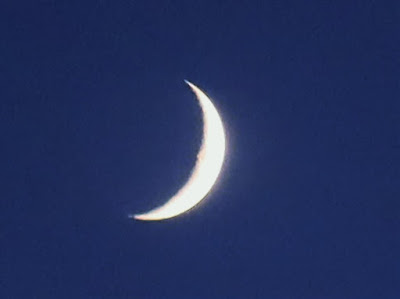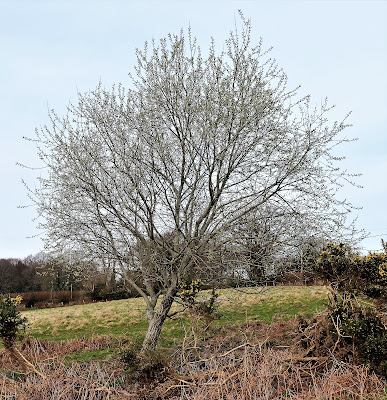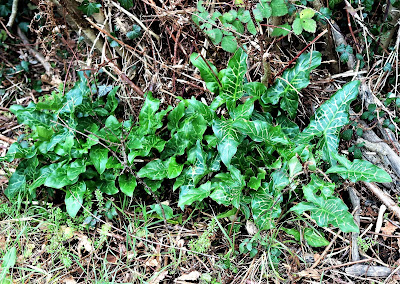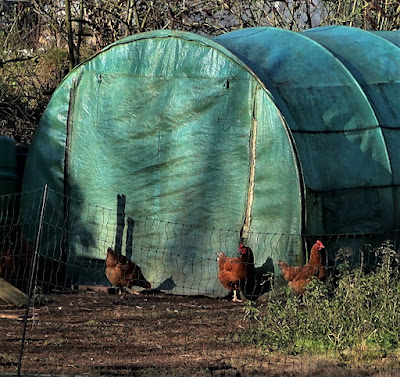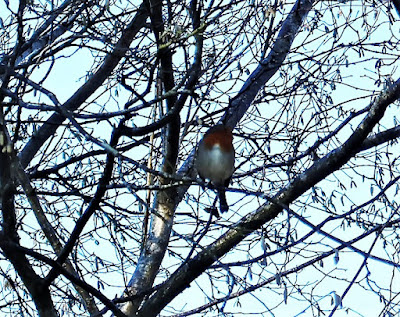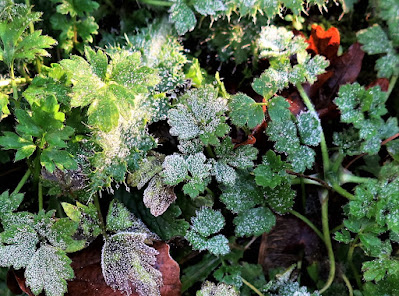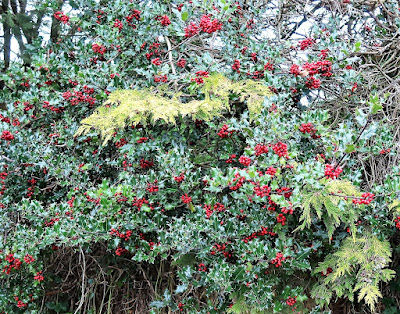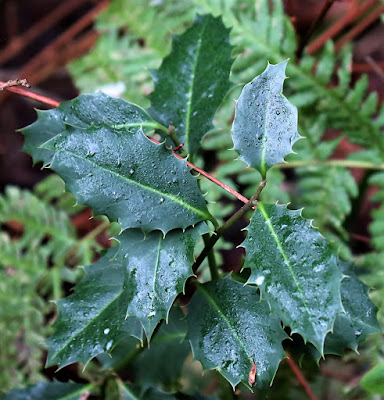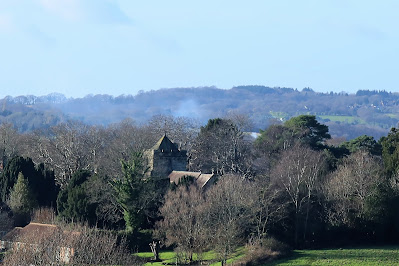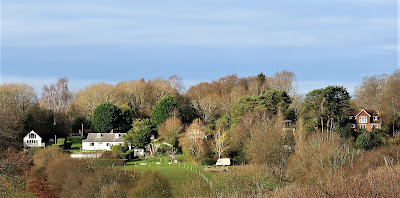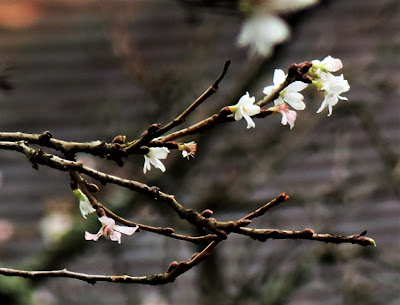I tottered round our dank and droopy garden this Boxing Day. In the summer we grew, quite successfully all sorts of vegetables on old hay bales. Any remaining were recently covered in snow.
As an ecologist and biodiversity researcher and recorder, the author visits a wide range of rural and urban habitats mainly close to his home in Sedlescombe near Hastings, East Sussex, UK. The weblog covers the full spectrum of wildlife, from mammals to microbes. As well as details of encounters with England’s flora and fauna, information on where to see species of interest is often given.
Monday, December 26, 2022
Back again
Wednesday, May 04, 2022
May 2022
1 May 2022. I normally take a walk every day ranging through field, wood, lanes and footpaths within about half a kilometre of home (TQ782188). I always take the camera and usually find something to photograph. Here I thought I might try a sort of daily picture diary.
Germander speedwell (below) in flower is now quite abundant. The name 'germander' comes from ancient Greek, via Old French and Old English, and means 'oak leaved'. The leaves were thought to resemble those of oak bu, as you can see in the picture, it is not a very good fit.
Saturday, April 30, 2022
April 2022
April this year has been very dry (the forecasters say we have only had about one third of the expected amount) and some of the plants locally have been showing signs of stress due to lack of water. Insects have been scarce, though I have seen the usual spring butterfly species: red admiral, brimstone, large white, orange tip, peacock, speckled wood and comma (below).
Wednesday, March 09, 2022
March 2022
1 March 2022 It has been a generally rather cold and drab start to the month with the mood not being helped by Russia's war on Ukraine. I am lucky in having a small area of wood, lane and field to enjoy away from the news. In his speech to the Commons on 8th March Ukrainian president Volodymyr Zelensky said his people would fight in the fields, the forests and on the riversides perhaps indicating how important these places are as emblematic of a home country. However, when the wind comes from the north, rattling the bare branches in Killingan Wood, it is difficult not to be saddened by the plight of those distant people in much deeper cold who have no home left to go back to.
9 March 2022 A gratefully warm day at last. There was enough afternoon sunshine to warm my back. On my walk my spirits were lifted by the patches of sunny celandine flowers along the verges of the lane. In the woods the white anemone flowers are a landscape feature and some of them have pink reverses to the petals and occasionally they are wholly pink.
I found several rosettes of heavily spotted early-purple orchid leaves and the Euphorbia robbiae (Mrs Robb's bonnet spurge) is at its best in the patch by Churchland Lane. New leaves are greening many of the trees like this hornbeam.
The garden in brightening up rapidly with several camellias now in flower as well as the Pieris 'Firecrest' at the end of the garden. In my Square Metre Mark 2 I found a small plant of bristly ox-tongue. This is, I think, the first time I have noticed this species in the garden and I wondered where it might have come from. The camellia below is the white semi-double 'Yuki-botan'.
15 March 2022 At last the weather feels more spring than winter and today I saw the first brimstone butterfly on the wing - a male. That flake of intense citrus yellow searching the garden air, looking for bluebells and buckthorn is like a flag from a starter - spring cannot be stopped now. In the garden it found our only plant of the grape hyacinth Muscari armeniacum.
Yesterday I found a large patch pf spring snowflake on the wood bank at the end of Churchland Lane. A surprise as I have been past the spot a thousand times without noticing it.
Later I ventured into Churchland Fields where the gorse is at its best and photographed a grey willow that stands alone. One seldom sees a free-standing tree of this species as they are normally muddled up with the scrub vegetation in regenerating secondary woodland.
Sunday, February 06, 2022
February 2022
9 February 2022. Although the daytime temperature has been hovering between 9 and 12 degrees, I managed today to do some useful work in the garden. Quite suddenly snowdrops have appeared on the far side of our lane and there are several lesser periwinkle flowers by the pond. I pottered about in the Square Metre, propping up the Cotoneaster franchetii and pruning hazels, oak, holly and hornbeam into more manageable shapes. On the holly I though I had spotted a leaf mine of Phytomyza illicis but it is very small and I will have to wait a bit to be certain.
 |
| Helleborus orientalis |
Thursday, January 06, 2022
January, 2022
31 January 2022 The end of a cold, dry month though with few frosts, all of them light. The lack of any significant rain for many days is, I think, affecting wildlife locally. Hazel catkins seem slower to expand, I have seen no celandine flowers, fallen leaves remain on the woodland floor like a fluffy, dry eiderdown. Still, there have been plenty of things to see and record.
We have several mahonias in the garden and these provide nectar rich flowers from November to February inclusive. One of the most magnificent is Mahonia x media 'Buckland' which flowers right through December and January.
Rather more modest but still an attractive plant is Mahonia japonica which flowers here from late January through March. It often attracts bumble and honey bees and blue tits raid the flowers for nectar, or I assume this is what they are finding.
A bit further south I found a small, self-sown bay tree (Laurus nobilis)a species not common in the wild. The leaves resemble laurustinus, which grows not far away, but the smell of the bay gives it away
 |
17 January 2022 Cold nights but sunny and cool days. A badger has been digging for worms in the newly exposed stretch of verge alongside Churchland Lane
The hazel catkins in the picture above mostly are closed, though higher up the bush they are starting to open (see below), while on the opposite side of the lane, in another bush, they are fully open.
14 January 2022
A sharp frost overnight whitened the grass in Churchland Fields and covered creeping buttercup leaves in my second Square Metre with Ice crystals like a scattering of sugar.
I noted two leaf mines in a frosted bramble leaf halfway down the garden. I am pretty sure these have been made by the larvae of the tiny moth Stigmella aurella (there are some similar species that mine bramble leaves). The larvae and pupae can survive frosts and, if occupied mines are brought indoors and kept in a jam jar, the moths like sooty, black sparklets will emerge often quite quickly.
One of my favourite books Birds and Berries by Barbara and David Snow (T & A D Poyser, 1988) says that black bryony berries are eaten, usually after they have been on the vine for some time, by blackbirds and thrushes, though robins will occasionally tackle them though they are rather too large to swallow in one go.
Black bryony berries (below) are toxic to humans but perhaps simply rather unpalatable to birds. The problems with humans and, presumably with other mammals, is that the berries (and root tubers) are full of calcium oxalate that forms tiny needle-sharp crystals that can penetrate skin and cell walls causing irritation which can be dangerous internally.
Two hollies in particular have caught my eye this autumn and winter . One was an example, probably of garden origin, with an exceptionally rich crop of berries hanging over a fence in Broad Oak Brede (below).
The other is a young plant on the fringe of my Square Metre project where it has been bird-sown from the overhanging medlar tree (see below). It looks like a form of Highclere holly, Ilex x altaclerensis, Judging by the shape and texture of the leaves and the prickles it is probably a hybrid between a garden form of Highclere holly and our native species, what is known as introgressive hybridisation. The I. x altaclerensis of horticulture is a hybrid between Ilex perado (probably from Madeira) and our native species. It is widely planted in gardens usually as a variegated clone with almost or completely spineless leaves.
10 January 2022
8 January 2022 Cold, hard rain all day and all night. I didn't venture forth. Instead I took this picture, blurred with rain, through the French windows out into the patch of garden I spend much of each day contemplating.
I wondered where the birds I usually see were sheltering. The commonest species (I don't have bird feeders) are blackbirds, hedge sparrows, wrens, robins, thrushes, wood pigeons and magpies. All the finches, except that occasional goldfinches and bullfinches, have disappeared and, of course, there are buzzards and things flying overhead that I cannot see. Indeed when the windows are covered with raindrops and my glasses are dirty I cannot see very much at all. It's cold indoors too.
6 January 2022 A sharp overnight frost leaving a white sheen over the lawn and silvered fallen leaves on the wooden ramp outside my window.
The terminal leaves of the spurge Euphorbia amygdaloides ssp. robbiae (Mrs Robb's bonnet) start to expand, in their bent over way, at this time of the year like narrow hop cones and contrasting with the old, darker green foliage. In a few weeks they will have grown into flower heads. This is one of the earliest signs that things are starting to move towards spring.
5 January 2022 A sunny, mild morning. In the hedge on the eastern side of the lane I found a single plant of Berberis darwinii. Though not very obvious, I was surprised at the number of times I must have walked past it without noticing it.
We have a very active thrush, perhaps a pair, in the garden that looks as though they will soon be starting to build a nest.
3 January 2022 A change of walking route took me right to the end of Churchland Lane (nearly half a kilometre from home). A few metres up Hurst Lane, in the front garden of Tresco, I stopped to look at the fragile blossoms on the winter flowering cherry, Prunus x subhirtella 'Autumnalis Rosea'.
New Year’s Day, 1 January 2022
Must get more done this year.
On the western side of Churchland Lane there is a 30 metre stretch of verge that has been cleared right back to the hedge. This has left a 2 metre wide stretch of somewhat disturbed, dark and rich looking soil with a variety of low growing plants and the saw-shattered stumps of young trees and shrubs. A distinctive feature on New Year’s Day was the many shiny green tufts of emerging Arum maculatum, cuckoopint, leaves perhaps a hint that this newly uncovered section of this verge will reveal much of interest in coming months.
In the garden the pink, single camellia (Camellia × williamsii 'J.C. Williams') always the first, has started flowering. My late wife used to refer to this as "her camellia", though there were many more varieties in the garden. I assume it was because she could see it from the kitchen window. The wintersweet (Chimonanthus praecox, là méi) in the flowerbed where the old shed used to stand is in full flower and casting its powerful scent on the air on milder days. This year it has perhaps the best display I have seen but the blossoms turn to a dowdy speckled yellow if there is much frost (so far this winter we have had only one or two nights of light frost and today the temperature reached 14°C, very high for the time of year).
Killingan Wood was calm and damp, a silent army of grey
trunked hornbeam trees, with a carpet of decaying fallen leaves braided by
muddy tracks.
On my walk I saw very few insects. Over most of my life warm
winter days like this have seen numerous small swarms of many insect species that are adapted
to flying only in the winter months. But they seem to have gone.
This will affect birds and spiders as well as the many small creatures that
must have fed on their fallen bodies and earlier stages. The consequences for biodiversity
are unknown.
Many writers reflect on the decline of the cuckoo, or the pearl
bordered fritillary, but this morning I would like to pay homage to an absent
friend: Gymnometriocnemus brumalis a winter flying, non-biting midge.
Maybe, if we have a cold spell, there will be a belated
emergence, but I hope 2022 will not be the year when we have to say goodbye to
this small winter flying insect.



